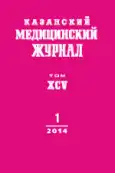Actual aspects of studying athlete’s body composition
- Authors: Rylova NV1,2
-
Affiliations:
- Volga Region State Academy of Physical Culture, Sports and Tourism, Kazan, Russia
- Kazan State Medical University, Kazan, Russia
- Issue: Vol 95, No 1 (2014)
- Pages: 108-111
- Section: Sports medicine and rehabilitation
- URL: https://bakhtiniada.ru/kazanmedj/article/view/1468
- DOI: https://doi.org/10.17816/KMJ1468
- ID: 1468
Cite item
Full Text
Abstract
Keywords
Full Text
##article.viewOnOriginalSite##About the authors
N V Rylova
Volga Region State Academy of Physical Culture, Sports and Tourism, Kazan, Russia; Kazan State Medical University, Kazan, Russia
Email: rilovanv@mail.ru
References
- Мартиросов Э.Г., Николаев Д.В., Руднев С.Г. Технологии и методы определения состава тела человека. - М.: Наука, 2006. - 248 c.
- Николаев Д.В., Смирнов А.В., Бобринская И.Г., Руднев С.Г. Биоимпедансный анализ состава тела человека. - М.: Наука, 2009. - 392 с.
- Романов Ю.Н. Функциональный мониторинг компонентного состава тела, осанки и экспресс-анализа мочи студентов-кикбоксёров на этапе предсоревновательной подготовки мезоцикла // Вестн. ЮУрГУ. - 2011. - №39. - С. 34-36.
- Рылова Н.В., Хафизова Г.Н. Актуальные проблемы питания юных спортсменов // Практ. мед. - 2012. - №7 (62). - С. 71-74.
- Ackland T.R., Lohman T.G., Sundgot-Borgen J. et al. Current status of body composition assessment in sport. Review and position statement on behalf of the ad hoc research working group on body composition health and performance, under the auspices of the I.O.C. medical commission // Sport med. - 2012. - Vol. 42, N 3. - P. 227-249.
- Andreoli A., Celi M., Volpe S.L. et al. Long-term effect of exercise on bone mineral density and body composition in pos-menopausal ex-elite athletes: a retrospective study // Eur. J. Clin. Nutr. - 2012. - Vol. 66, N 1. - Р. 69-74.
- Carbuhn A.F., Fernandez T.E., Bragg A.F. et al. Sport and training influence bone and body composition in women collegiate athletes // J. Strength Cond. Res. - 2010. - Vol. 24, N 7. - P. 1710-1717.
- Esco M.R., Olson M.S., Williford H.N. et al. The accuracy of hand-to-hand bioelectrical impedance analysis in predicting body composition in college-age female athletes // J. Strength Cond. Res. - 2011. - Vol. 25, N 4. - Р. 1040-1045.
- Garrido-Chamorro R.P., Sirvent-Belando J.E., Gonzales-Lorenzo M. et al. Correlation between body mass index and body composition in elite athletes // J. Sports Med. Phys. Fitness. - 2009. - Vol. 49, N 3. - P. 278-284.
- Garthe I., Raastad T., Refsnes P.E. et al. Effect of two different weight-loss rates on body composition and strength and power-related performance in elite athletes // Int. J. Sport Nutr. Exers. Metab. - 2011. - Vol. 21, N 2. - P. 97-104.
- Giampietro M., Pujia A., Bertini I. Antropometric features and body composition of young athletes practicing karate at a high and medium competitive level // Acta Diabetol. - 2003. - Vol. 40, suppl. 1. - P. 145-148.
- Hartgens F., Kuipers H. Effects of androgenic-anabolic steroids in athletes // Sport Med. - 2004. - Vol. 34. - Р. 513-554.
- Josse A.R., Pillips S.M. Impact of milk consumption and resistance training on body composition of female athletes // Med. Sport Sci. - 2012. - Vol. 59. - P. 94-103.
- Knechtle B., Knechtle P., Rosemann T. No dehydration in mountain bike ultra-marathores // Senn. Clin. J. Sports Med. - 2009. - Vol. 19, N 5. - Р. 415-420.
- Logan-Sprenger H.M. Estimated fluid and sodium balance and drink preferences in elite male junior players during an ice hockey game // Appl. Physiol. Nutr. Metab. - 2011. - Vol. 36, N 1. - P. 145-152.
- Mattsson S., Thomas B.J. Development of methods for body composition studies // Phys. Med. Biol. - 2006. - Vol. 51, N 13. - Р. 2003-2028.
- Ostojic S.M. Estimation of body fat in athletes: skinfolds vs bioelectrical impedance // J. Sports Med. Phys. Fitness. - 2006. - Vol. 46, N 3. - Р. 442-446.
- Palmer M.S., Spriet L.L. Sweat rate, salt loss, and fluid intake during an intense on-ice practice in elite Canadian male junior hockey players // Appl. Physiol. Nutr. Metab. - 2008. - Vol. 33, N 2. - P. 263-271.
- Pineau J.C., Filliard J.R., Bocquest M. Ultrasound techniques applied to body fat measurement in male and female athletes // J. Athl. Train. - 2009. - Vol. 44, N 2. - Р. 142-147.
- Potteiger J.A., Smith D.L., Maier M.L., Foster T.S. Relationship between body composition, leg strength, anaerobic power, and on-ice skating performance in division I men’s hockey athletes // J. Strength Cond. Res. - 2010. - Vol. 24, N 7. - P. 1755-1762.
- Quiterio A.L., Carnero E.A., Silva A.M. et al. Weekly training hours are associated with molecular and cellular body composition levels in adolescent athletes // J. Sports Med. - 2009. - Vol. 49, N 1. - Р. 54-63.
- Quiterio A.L., Silva A.M., Minderico C.S. et al. Total body water measurements in adolescent athletes: a comparison of six field methods with deuterium dilution // J. Strength Cond. Res. - 2009. - Vol. 23, N 4. -
- -1237.
- Silva A.M., Fields D.A., Quiterio A.L., Sardinha L.B. Аre skinfold-based models accurate and suitable for assessing changes in body composition in highly trained athletes? // J. Strength Cond. Res. - 2009. - Vol. 23, N 6. - Р. 1688-1696.
- Silva A.M., Fields D.A., Heymsfield S.B., Sardinha L.B. Body composition and power changes in elite judo athletes // Int. J. Sorts Med. - 2010. - Vol. 31, N 10. - Р. 737-741.
- Sundgot-Borgen J., Garthe I. Elite athletes in aesthetic and Olimpic weight-class sports and the challenge of body weight and body compositions // J. Sports Sci. - 2011. - Vol. 29, suppl. 1. - P. 101-114.
- Ward L.C. Segmental bioelectrical impedance analysis: an update // Curr. Opin. Clin. Nutr. Metab. Care. - 2012. - Vol. 15, N 5. - Р. 424-429.
Supplementary files






